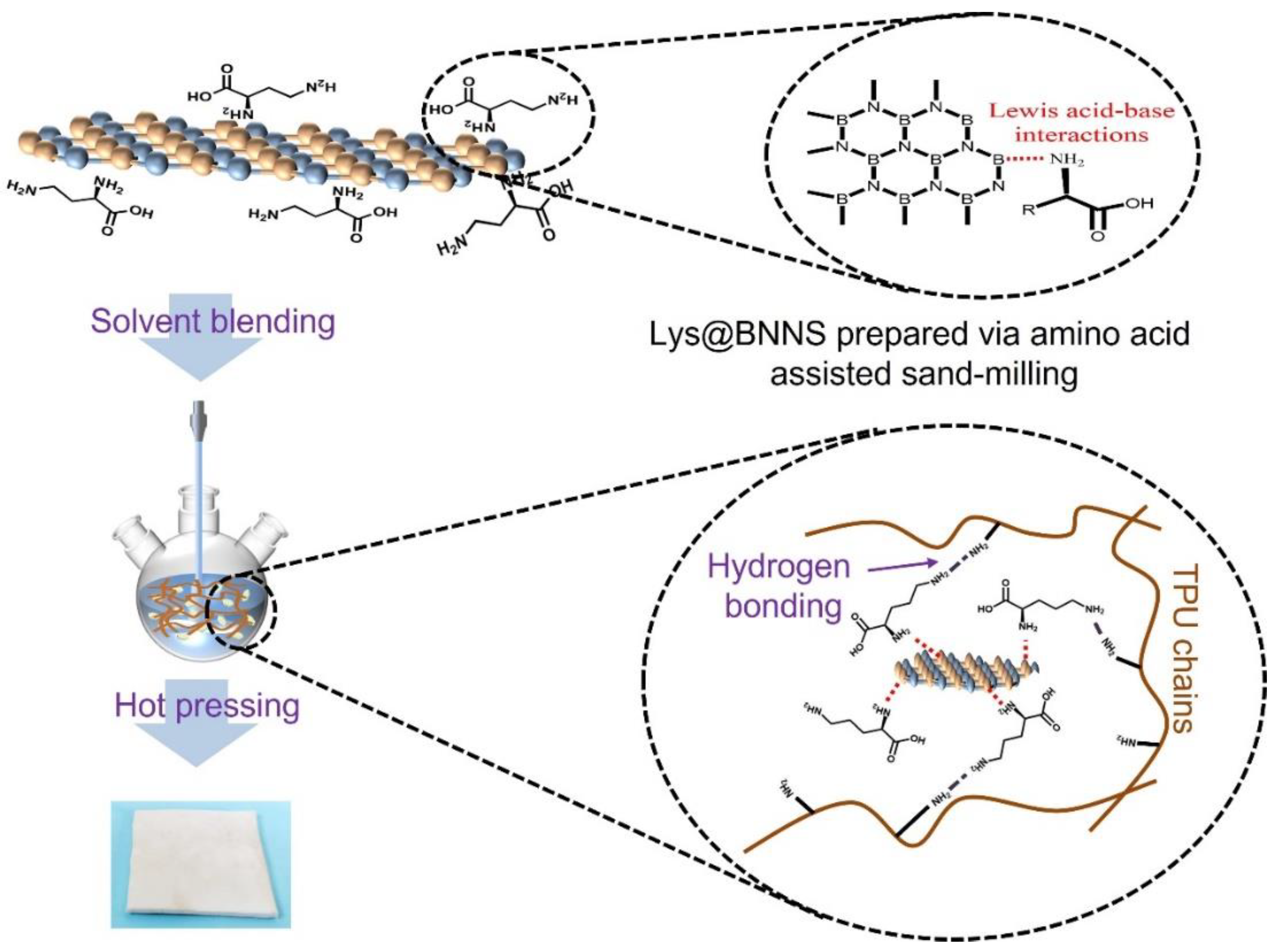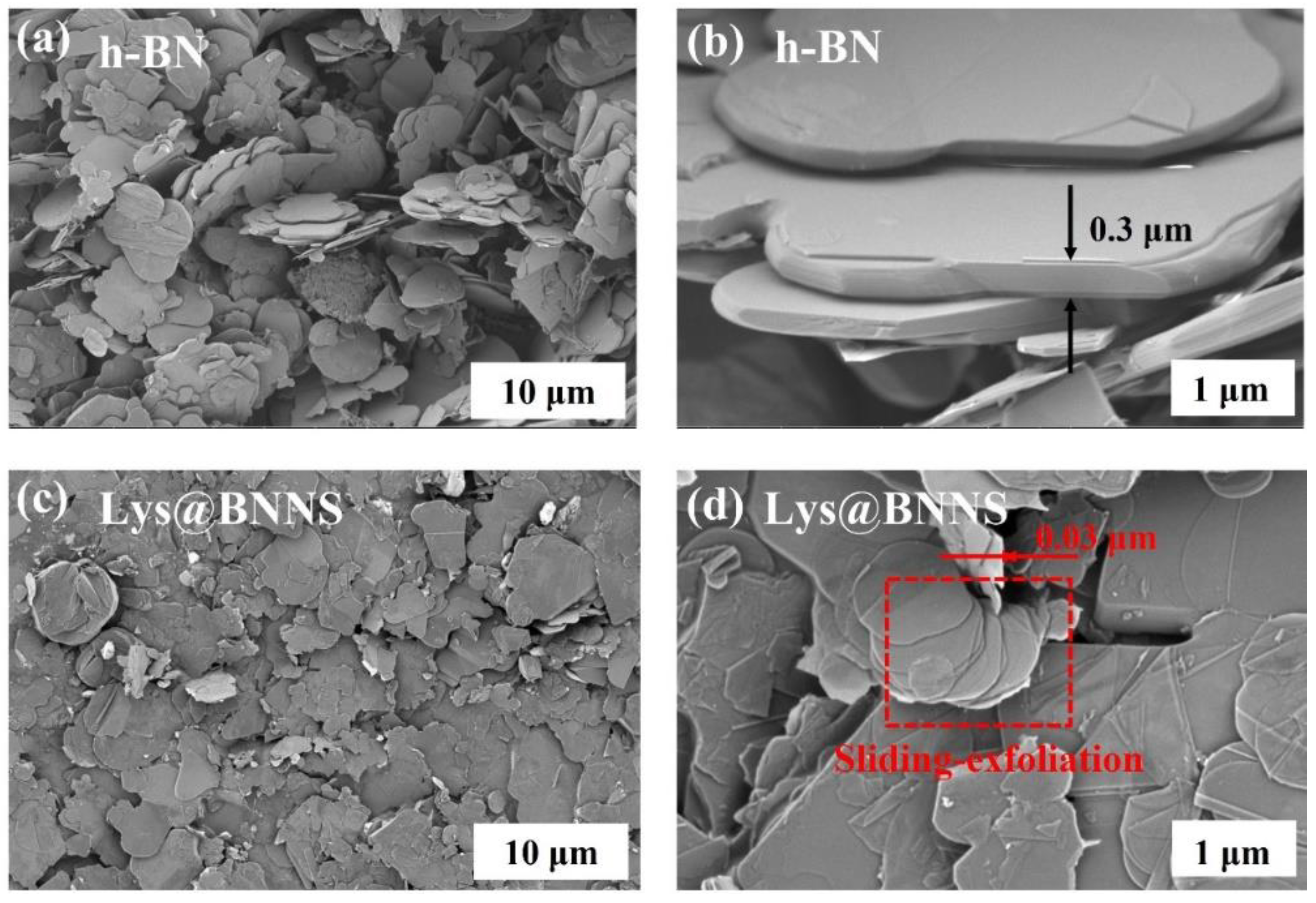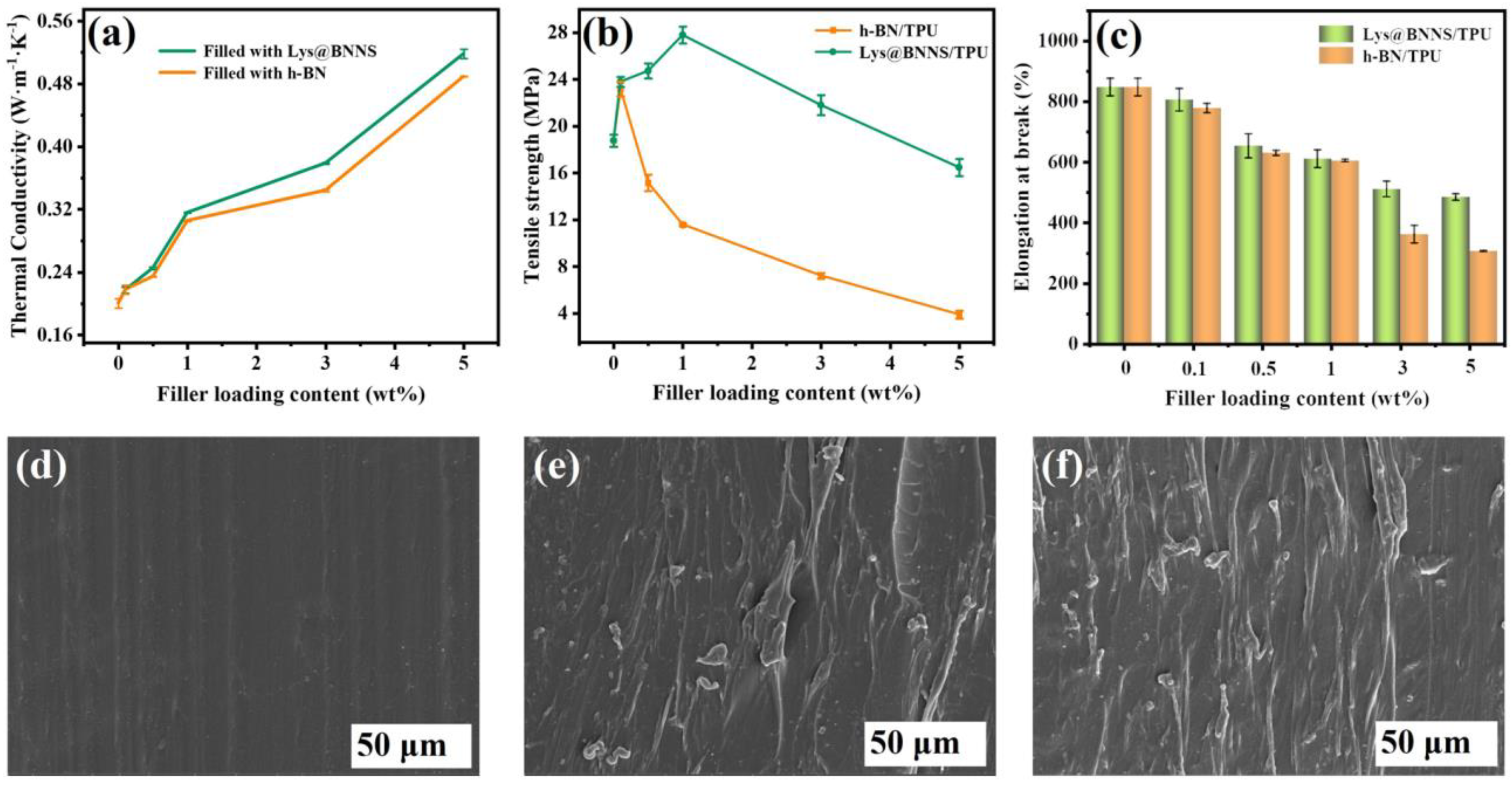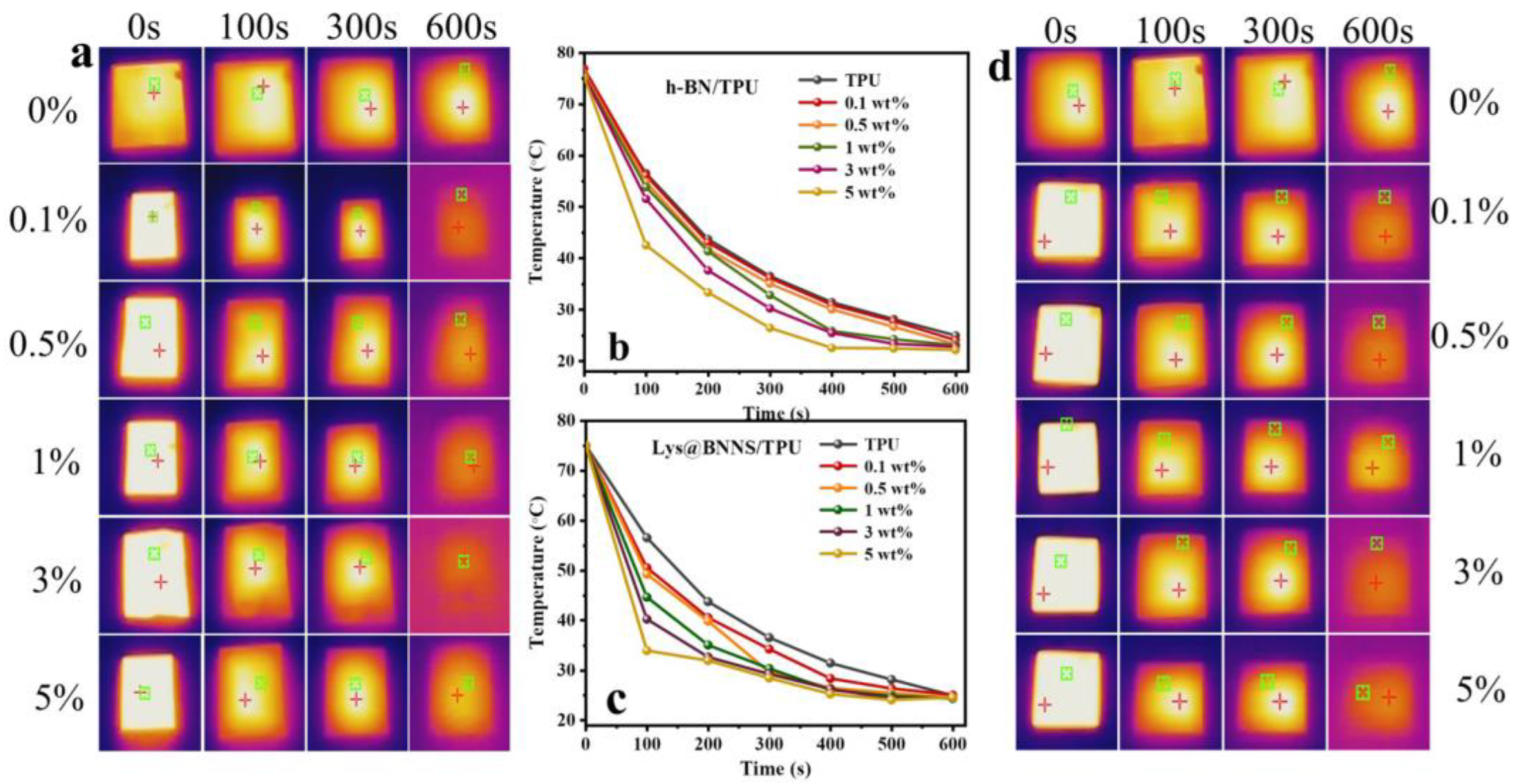Amino Acid-Assisted Sand-Milling Exfoliation of Boron Nitride Nanosheets for High Thermally Conductive Thermoplastic Polyurethane Composites
Abstract
1. Introduction
2. Materials and Methods
2.1. Materials
2.2. Preparation of Lys@BNNSs
2.3. Preparation of TPU Composites
2.4. Measurements and Characterization
3. Results and Discussion
3.1. Characterizations of Lys@BNNSs
3.2. Characterizations of TPU Composites
4. Conclusions
Author Contributions
Funding
Institutional Review Board Statement
Informed Consent Statement
Data Availability Statement
Conflicts of Interest
References
- Novoselov, K.S.; Jiang, D.; Schedin, F.; Booth, T.J.; Khotkevich, V.V.; Morozov, S.V.; Geim, A.K. Two-dimensional atomic crystals. Proc. Natl. Acad. Sci. USA 2005, 102, 10451–10453. [Google Scholar] [CrossRef] [PubMed]
- Hou, X.M.; Yu, Z.Y.; Chou, K.C. Facile synthesis of hexagonal boron nitride fibers with uniform morphology. Ceram Int. 2013, 39, 6427–6431. [Google Scholar] [CrossRef]
- Morishita, T.; Okamoto, H.; Katagiri, Y.; Matsushita, M.; Fukumori, Z. A high-yield ionic liquid-promoted synthesis of boron nitride nanosheets by direct exfoliation. Chem. Commun. 2015, 51, 12068–12071. [Google Scholar] [CrossRef] [PubMed]
- Zhang, R.C.; Sun, D.; Lu, A.; Zhang, R.C.; Sun, D.; Lu, A.; Askari, S.; Macias-Montero, M.; Joseph, P.; Dixon, D.; et al. Microplasma processed ultrathin boron nitride nanosheets for polymer nanocomposites with enhanced thermal transport performance. ACS Appl. Mater. Interfaces 2016, 8, 13567–13572. [Google Scholar] [CrossRef]
- Wang, Z.F.; Tang, Z.J.; Huang, Y.; Huang, Y.; Zhu, M.S.; Pei, Z.X.; Li, H.F.; Jiang, H.B.; Fu, C.X.; Zhi, C.Y. Fabrication of boron nitride nanosheets by exfoliation. Chem. Rec. 2016, 16, 1204–1215. [Google Scholar] [CrossRef]
- Zheng, X.W.; Cong, H.F.; Yang, T.; Ji, K.M.; Wang, C.Y.; Chen, M.M. High-efficiency 2D nanosheet exfoliation by a solid suspension-improving method. Nanotechnology 2022, 33, 185602. [Google Scholar] [CrossRef]
- Zhi, C.Y.; Bando, Y.; Tang, C.C.; Kuwahara, H.; Golberg, D. Large-scale fabrication of boron nitride nanosheets and their utilization in polymeric composites with improved thermal and mechanical properties. Adv. Mater. 2009, 21, 2889–2893. [Google Scholar] [CrossRef]
- Cai, W.; Mu, X.W.; Pan, Y.; Guo, W.W.; Wang, J.L.; Yuan, B.H.; Feng, X.M.; Tai, Q.L.; Hu, Y. Facile fabrication of organically modified boron nitride nanosheets and its effect on the thermal stability, flame retardant, and mechanical properties of thermoplastic polyurethane. Polym. Adv. Technol. 2018, 29, 2545–2552. [Google Scholar] [CrossRef]
- Wang, Y.X.; Wang, J.D.; Zheng, P.; Sun, C.Y.; Luo, J.Y.; Xie, X.W. Boosting selectivity and stability on Pt/BN catalysts for propane dehydrogenation via calcination & reduction-mediated strong metal support interaction. J. Energy Chem. 2021, 67, 451–457. [Google Scholar]
- Kovalskii, A.M.; Volkov, I.N.; Evdokimenko, N.D.; Tkachenko, O.P.; Leybo, D.V.; Chepkasov, I.V.; Popov, Z.I.; Matveev, A.T.; Manakhov, A.; Permyakova, E.S.; et al. Hexagonal BN- and BNO-supported Au and Pt nanocatalysts in carbon monoxide oxidation and carbon dioxide hydrogenation reactions. Appl. Catal. B-Environ. 2022, 303, 120891. [Google Scholar] [CrossRef]
- Gao, W.J.; Liu, Y.Y.; Cao, C.C.; Zhang, Y.G.; Xue, Y.M.; Tang, C.C. Boron nitride nanosheets wrapped by reduced graphene oxide for promoting polysulfides adsorption in lithium-sulfur batteries. J. Colloid Interface Sci. 2021, 610, 527–537. [Google Scholar] [CrossRef] [PubMed]
- Chao, Y.H.; Liu, M.; Pang, J.Y.; Wu, P.W.; Jin, Y.; Li, X.W.; Luo, J.; Xiong, J.; Li, H.M.; Zhu, W.S. Gas-assisted exfoliation of boron nitride nanosheets enhancing adsorption performance. Ceram Int. 2019, 45, 18838–18843. [Google Scholar] [CrossRef]
- Weng, Q.H.; Wang, X.B.; Wang, X.; Bando, Y.; Golberg, D. Functionalized hexagonal boron nitride nanomaterials: Emerging properties and applications. Chem. Soc. Rev. 2016, 45, 3989–4012. [Google Scholar] [CrossRef] [PubMed]
- Lei, W.W.; Zhang, H.; Wu, Y.; Zhang, B.; Liu, D.; Qin, S.; Liu, Z.W.; Liu, L.M.; Ma, Y.M.; Chen, Y. Oxygen-doped boron nitride nanosheets with excellent performance in hydrogen storage. Nano Energy 2014, 6, 219–224. [Google Scholar] [CrossRef]
- Wu, M.; Zhou, Y.L.; Zhang, H.; Liao, W.G. 2D boron nitride nanosheets for smart thermal management and advanced dielectrics. Adv. Mater. Interfaces 2022, 9, 2200610. [Google Scholar] [CrossRef]
- Guerra, V.; Wan, C.Y.; McNally, T. Thermal conductivity of 2D nano-structured(BN) and its composites with polymers. Prog. Mater. Sci. 2019, 100, 170–186. [Google Scholar] [CrossRef]
- Luo, W.; Wang, Y.B.; Hitz, E.; Lin, Y.; Yang, B.; Hu, L.B. Solution processed boron nitride nanosheets: Synthesis, assemblies and emerging applications. Adv. Funct. Mater. 2017, 27, 1701450. [Google Scholar] [CrossRef]
- Biscarat, J.; Bechelany, M.; Pochat-Bohatier, C.; Miele, P. Graphene-like BN/gelatin nanobiocomposites for gas barrier applications. Nanoscale 2015, 7, 613–618. [Google Scholar] [CrossRef]
- Ortiz, D.G.; Pochat-BOhatier, C.; Cambedouzou, J.; Bechelany, M.; Miele, P. Exfoliation of hexagonal boron nitride (h-BN) in liquid phase by ion intercalation. Nanomaterials 2018, 8, 716. [Google Scholar] [CrossRef]
- Thalib, N.B.; Mustapha, S.N.H.; Feng, C.K.; Mustapha, R. Tailoring graphene reinforced thermoset and biothermoset composites. Rev. Chem. Eng. 2020, 36, 623–652. [Google Scholar] [CrossRef]
- Sui, G.P.; Liu, D.Y.; Liu, Y.H.; Ji, W.J.; Zhang, Q.; Fu, Q. The dispersion of CNT in TPU matrix with different preparation methods: Solution mixing vs melt mixing. Polymer 2019, 182, 121838. [Google Scholar] [CrossRef]
- Guo, H.Y.; Xu, T.L.; Zhou, S.S.; Jiang, F.; Jin, L.Y.; Song, N.; Ding, P. A technique engineered for improving thermal conductive properties of polyamide-6 composites via hydroxylated boron nitride masterbatch-based melt blending. Compos. Part B-Eng. 2021, 212, 108716. [Google Scholar] [CrossRef]
- Yang, N.; Ji, H.F.; Jiang, X.X.; Qu, X.W.; Zhang, X.J.; Zhang, Y.; Liu, B.Y. Preparation of boron nitride nanoplatelets via amino acid assisted ball milling: Towards thermal conductivity application. Nanomaterials 2020, 10, 1652. [Google Scholar] [CrossRef] [PubMed]
- Najafi, F.; Farzad, F.; Pasban, S. Interactions of boron nitride nanosheet with amino acids of differential polarity. Sci. Rep.-UK 2022, 12, 1–12. [Google Scholar] [CrossRef] [PubMed]
- Wu, N.; Yang, W.; Li, H.W.; Che, S.; Gao, C.; Jiang, B.; Li, Z.X.; Xu, C.; Wang, X.B.; Li, Y.F. Amino acid functionalized boron nitride nanosheets towards enhanced thermal and mechanical performance of epoxy composite. J. Colloid Interface Sci. 2022, 619, 388–398. [Google Scholar] [CrossRef]
- Yuan, C.; Duan, B.; Li, L.; Xie, B.; Huang, M.Y.; Luo, X.B. Thermal conductivity of polymer-based composites with magnetic aligned hexagonal boron nitride platelets. ACS Appl. Mater. Interfaces 2015, 7, 13000–13006. [Google Scholar] [CrossRef]
- Mo, Z.L.; Gou, H.; He, J.X.; Yang, P.P.; Feng, C.; Guo, R.B. Controllable synthesis of functional nanocomposites: Covalently functionalize graphene sheets with biocompatible L-lysine. Appl. Surf. Sci. 2012, 258, 8623–8628. [Google Scholar] [CrossRef]
- Shi, Y.M.; Hamsen, C.; Jia, X.T.; Kim, K.K.; Reina, A.; Hofmann, M.; Hsu, A.L.; Zhang, K.; Li, H.N.; Juang, Z.Y.; et al. Synthesis of few-layer hexagonal boron nitride thin film by chemical vapor deposition. Nano Lett. 2010, 10, 4134–4139. [Google Scholar] [CrossRef]
- Ko, W.Y.; Chen, C.Y.; Chen, W.H.; Lin, K.J. Fabrication of hexagonal boron nitride nanosheets by using a simple thermal exfoliation process. J. Chin. Chem Soc. 2016, 63, 303–307. [Google Scholar] [CrossRef]
- Wang, J.W.; Li, H.R.; Li, G.H.; Liu, Z.X.; Zhang, Q.X.; Wang, N.Y.; Qu, X.W. Noncovalent functionalization of boron nitride and its effect on the thermal conductivity of polycarbonate composites. J. Appl. Polym. Sci. 2017, 134, 1–9. [Google Scholar] [CrossRef]
- Lei, W.W.; Mochalin, V.N.; Liu, D.; Qin, S.; Gogotsi, Y.; Chen, Y. Boron nitride colloidal solutions, ultralight aerogels and freestanding membranes through one-step exfoliation and functionalization. Nat. Commun. 2015, 6, 8849. [Google Scholar] [CrossRef] [PubMed]
- Cao, C.C.; Xue, Y.M.; Liu, Z.Y.; Zhou, Z.; Ji, J.W.; Song, Q.Q.; Hu, Q.; Fang, Y.; Tang, C.C. Scalable exfoliation and gradable separation of boric-acid-functionalized boron nitride nanosheets. 2D Mater. 2019, 6, 035014. [Google Scholar] [CrossRef]
- Yuan, F.; Jiao, W.C.; Yang, F.; Liu, W.B.; Xu, Z.H.; Wang, R.G. Surface modification and magnetic alignment of hexagonal boron nitride nanosheets for highly thermally conductive composites. RSC Adv. 2017, 7, 43380–43389. [Google Scholar] [CrossRef]
- Goldberg, D.; Bando, Y.; Eremets, M.; Takemura, K.; Kurashima, K.; Tamiya, K.; Yusa, H. Boron nitride nanotube growth defects and their annealing-out under electron irradiation. Chem. Phys. Lett. 1997, 279, 191–196. [Google Scholar] [CrossRef]
- Ma, T.B.; Zhao, Y.S.; Ruan, K.P.; Liu, X.R.; Zhang, J.L.; Guo, Y.Q.; Yang, X.T.; Kong, J.; Gu, J.W. Highly thermal conductivities, excellent mechanical robustness and flexibility, and outstanding thermal stabilities of aramid nanofiber composite papers with nacre-mimetic layered structures. ACS Appl. Mater. Interfaces 2020, 12, 1677–1686. [Google Scholar] [CrossRef] [PubMed]
- Ruan, K.P.; Shi, X.T.; Guo, Y.Q.; Gu, J.W. Interfacial thermal resistance in thermally conductive polymer composites: A review. Compos. Commun. 2020, 22, 100518. [Google Scholar] [CrossRef]
- Wu, H.C.; Kessler, M.R. Multifunctional cyanate ester nanocomposites reinforced by hexagonal boron nitride after noncovalent biomimetic functionalization. ACS Appl. Mater. Interfaces 2015, 7, 5915–5926. [Google Scholar] [CrossRef]
- Hu, J.T.; Huang, Y.; Yao, Y.M.; Pan, G.R.; Sun, J.J.; Zeng, X.L.; Sun, R.; Xu, J.B.; Song, B.; Wong, C.P. Polymer composite with improved thermal conductivity by constructing hierarchically ordered three-dimensional interconnected network of BN. ACS Appl. Mater. Interfaces 2017, 9, 13544–13553. [Google Scholar] [CrossRef]
- Ryu, S.; Oh, H.; Kim, J. Facile liquid-exfoliation process of boron nitride nanosheets for thermal conductive polyphthalamide composite. Polymers 2019, 11, 1628. [Google Scholar] [CrossRef]
- Wang, Z.; Wen, Y.Y.; Zhao, S.J.; Zhang, W.; Ji, Y.; Zhang, S.F.; Li, J.Z. Soy protein as a sustainable surfactant to functionalize boron nitride nanosheets and its application for preparing thermally conductive biobased composites. Ind. Crops Prod. 2019, 137, 239–247. [Google Scholar] [CrossRef]







| Filler | Matrix | Filler Content | TC (W·m−1·K−1) | Reference |
|---|---|---|---|---|
| BNNS-OH | PA-6 | 10 wt% | 0.499 | [20] |
| Lys@BNNPs | PVA hydrogel | 11.3 wt% | 0.91 | [21] |
| BNNS-Trp | EP | 30 wt% | 2.1 | [23] |
| CBN | PC | 20 wt% | 0.7341 | [28] |
| BNNS | TPU | 30 wt% | 5.15 | [31] |
| BNNS@PDA | ANF | 50 wt% | 3.33 | [33] |
| h-BN | BECy | 15 vol% | 0.55 | [35] |
| 3D-BN network | EP | 34 vol% | 4.42 | [36] |
| BNNS | PPA | 44 wt% | 2.89 | [37] |
| SPI-BNNS | TA@CNF | 1 wt% | 6.881 | [38] |
| Lys@BNNSs | TPU | 5 wt% | 0.52 | this work |
Publisher’s Note: MDPI stays neutral with regard to jurisdictional claims in published maps and institutional affiliations. |
© 2022 by the authors. Licensee MDPI, Basel, Switzerland. This article is an open access article distributed under the terms and conditions of the Creative Commons Attribution (CC BY) license (https://creativecommons.org/licenses/by/4.0/).
Share and Cite
Zheng, S.; Wang, B.; Zhang, X.; Qu, X. Amino Acid-Assisted Sand-Milling Exfoliation of Boron Nitride Nanosheets for High Thermally Conductive Thermoplastic Polyurethane Composites. Polymers 2022, 14, 4674. https://doi.org/10.3390/polym14214674
Zheng S, Wang B, Zhang X, Qu X. Amino Acid-Assisted Sand-Milling Exfoliation of Boron Nitride Nanosheets for High Thermally Conductive Thermoplastic Polyurethane Composites. Polymers. 2022; 14(21):4674. https://doi.org/10.3390/polym14214674
Chicago/Turabian StyleZheng, Shihao, Bing Wang, Xiaojie Zhang, and Xiongwei Qu. 2022. "Amino Acid-Assisted Sand-Milling Exfoliation of Boron Nitride Nanosheets for High Thermally Conductive Thermoplastic Polyurethane Composites" Polymers 14, no. 21: 4674. https://doi.org/10.3390/polym14214674
APA StyleZheng, S., Wang, B., Zhang, X., & Qu, X. (2022). Amino Acid-Assisted Sand-Milling Exfoliation of Boron Nitride Nanosheets for High Thermally Conductive Thermoplastic Polyurethane Composites. Polymers, 14(21), 4674. https://doi.org/10.3390/polym14214674







